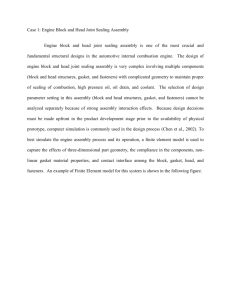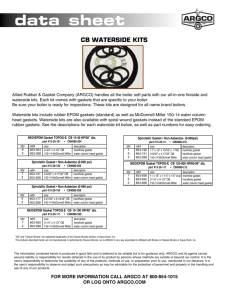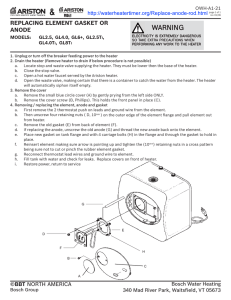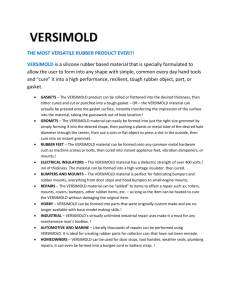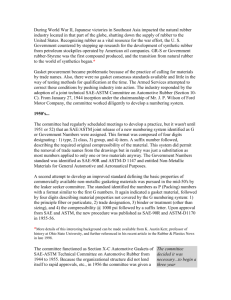paper. The results denote similar trend data between simulation et.al Abstract
advertisement
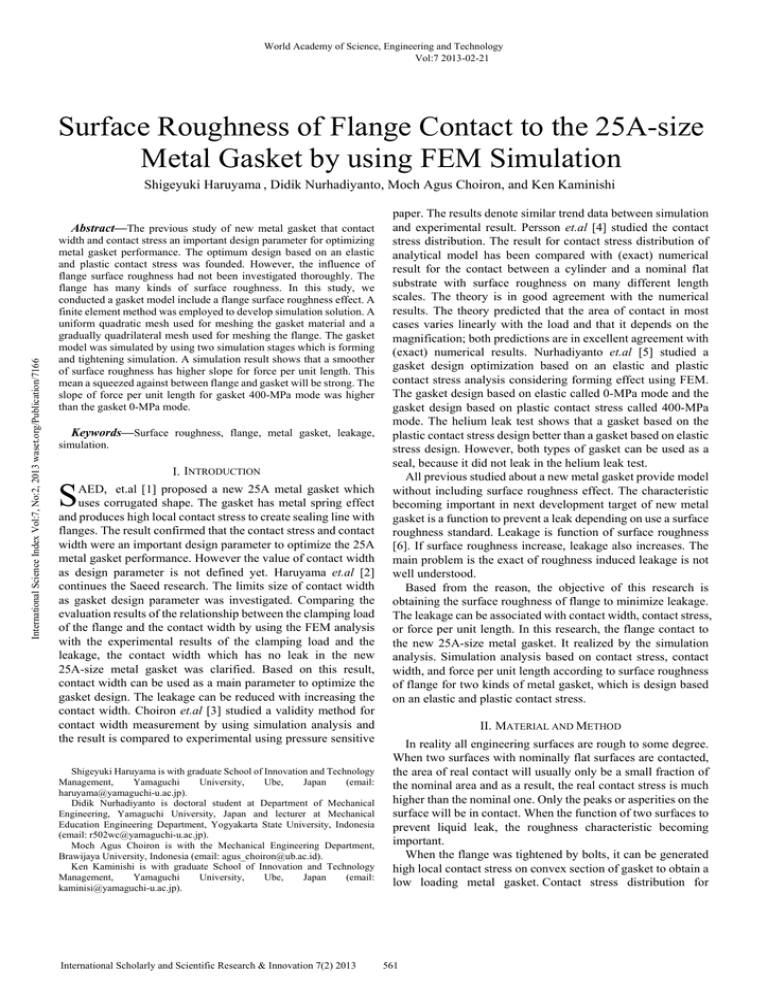
World Academy of Science, Engineering and Technology Vol:7 2013-02-21 Surface Roughness of Flange Contact to the 25A-size Metal Gasket by using FEM Simulation Shigeyuki Haruyama , Didik Nurhadiyanto, Moch Agus Choiron, and Ken Kaminishi International Science Index Vol:7, No:2, 2013 waset.org/Publication/7166 Abstract—The previous study of new metal gasket that contact width and contact stress an important design parameter for optimizing metal gasket performance. The optimum design based on an elastic and plastic contact stress was founded. However, the influence of flange surface roughness had not been investigated thoroughly. The flange has many kinds of surface roughness. In this study, we conducted a gasket model include a flange surface roughness effect. A finite element method was employed to develop simulation solution. A uniform quadratic mesh used for meshing the gasket material and a gradually quadrilateral mesh used for meshing the flange. The gasket model was simulated by using two simulation stages which is forming and tightening simulation. A simulation result shows that a smoother of surface roughness has higher slope for force per unit length. This mean a squeezed against between flange and gasket will be strong. The slope of force per unit length for gasket 400-MPa mode was higher than the gasket 0-MPa mode. Keywords—Surface roughness, flange, metal gasket, leakage, simulation. I. INTRODUCTION S AED, et.al [1] proposed a new 25A metal gasket which uses corrugated shape. The gasket has metal spring effect and produces high local contact stress to create sealing line with flanges. The result confirmed that the contact stress and contact width were an important design parameter to optimize the 25A metal gasket performance. However the value of contact width as design parameter is not defined yet. Haruyama et.al [2] continues the Saeed research. The limits size of contact width as gasket design parameter was investigated. Comparing the evaluation results of the relationship between the clamping load of the flange and the contact width by using the FEM analysis with the experimental results of the clamping load and the leakage, the contact width which has no leak in the new 25A-size metal gasket was clarified. Based on this result, contact width can be used as a main parameter to optimize the gasket design. The leakage can be reduced with increasing the contact width. Choiron et.al [3] studied a validity method for contact width measurement by using simulation analysis and the result is compared to experimental using pressure sensitive Shigeyuki Haruyama is with graduate School of Innovation and Technology Management, Yamaguchi University, Ube, Japan (email: haruyama@yamaguchi-u.ac.jp). Didik Nurhadiyanto is doctoral student at Department of Mechanical Engineering, Yamaguchi University, Japan and lecturer at Mechanical Education Engineering Department, Yogyakarta State University, Indonesia (email: r502wc@yamaguchi-u.ac.jp). Moch Agus Choiron is with the Mechanical Engineering Department, Brawijaya University, Indonesia (email: agus_choiron@ub.ac.id). Ken Kaminishi is with graduate School of Innovation and Technology Management, Yamaguchi University, Ube, Japan (email: kaminisi@yamaguchi-u.ac.jp). International Scholarly and Scientific Research & Innovation 7(2) 2013 paper. The results denote similar trend data between simulation and experimental result. Persson et.al [4] studied the contact stress distribution. The result for contact stress distribution of analytical model has been compared with (exact) numerical result for the contact between a cylinder and a nominal flat substrate with surface roughness on many different length scales. The theory is in good agreement with the numerical results. The theory predicted that the area of contact in most cases varies linearly with the load and that it depends on the magnification; both predictions are in excellent agreement with (exact) numerical results. Nurhadiyanto et.al [5] studied a gasket design optimization based on an elastic and plastic contact stress analysis considering forming effect using FEM. The gasket design based on elastic called 0-MPa mode and the gasket design based on plastic contact stress called 400-MPa mode. The helium leak test shows that a gasket based on the plastic contact stress design better than a gasket based on elastic stress design. However, both types of gasket can be used as a seal, because it did not leak in the helium leak test. All previous studied about a new metal gasket provide model without including surface roughness effect. The characteristic becoming important in next development target of new metal gasket is a function to prevent a leak depending on use a surface roughness standard. Leakage is function of surface roughness [6]. If surface roughness increase, leakage also increases. The main problem is the exact of roughness induced leakage is not well understood. Based from the reason, the objective of this research is obtaining the surface roughness of flange to minimize leakage. The leakage can be associated with contact width, contact stress, or force per unit length. In this research, the flange contact to the new 25A-size metal gasket. It realized by the simulation analysis. Simulation analysis based on contact stress, contact width, and force per unit length according to surface roughness of flange for two kinds of metal gasket, which is design based on an elastic and plastic contact stress. II. MATERIAL AND METHOD In reality all engineering surfaces are rough to some degree. When two surfaces with nominally flat surfaces are contacted, the area of real contact will usually only be a small fraction of the nominal area and as a result, the real contact stress is much higher than the nominal one. Only the peaks or asperities on the surface will be in contact. When the function of two surfaces to prevent liquid leak, the roughness characteristic becoming important. When the flange was tightened by bolts, it can be generated high local contact stress on convex section of gasket to obtain a low loading metal gasket. Contact stress distribution for 561 International Science Index Vol:7, No:2, 2013 waset.org/Publication/7166 World Academy of Science, Engineering and Technology Vol:7 2013-02-21 corrugated metal gasket is higher than flat metal gasket. This is because contact stress distributed in convex section. Also, the elastic regions on the flat sections produce the spring effect of metal gasket, and it can be reduce the effect of the occurring of loosening of bolts. Based on this comparison, the new metal is preferred to obtain a low loading metal gasket. The direct analysis to perform of the contact between two rough surfaces is very difficult. Many researchers transform the contact between two rough deformable surfaces into the contact between smooth surface and rough deformable surface [7]-[10]. This defined so-called sum surface. The micro geometric parameters of each surface are combined to obtain the parameters of the sum surface. The surfaces of most materials are rough and contain irregular geometric (asperities) with features size ranging over many length scales. Many models follow the approach devised by Greenwood and Williamson [11], who chose to idealize a rough surface as a collection of asperities with spherical tips. In their model, all the asperities have the same curvature, but their heights vary. In practice, however, it has proved difficult to apply the Greenwood-Williamson model to realistic surfaces. It is impossible to measure accurately the average curvature of asperities on real surfaces. This is because most surfaces have an approximately fractal (self-affine) geometry over a wide range of length scales. Gao et.al [12] analyzed in detail the behavior of an elastic-perfectly plastic solid, with sinusoidal rough surface, which is subjected to contact loading. So in the present research, we used a sinusoidal rough surface. For measuring the surface roughness used Handysurf E-35B serial KA8616BE machine by Tokyo Seimitsu Co., LTD. The surface roughness measurement based on JISB0601-2001 standard [13]. To avoid the experiment error due to the surface roughness, the equipment was also calibrated. All function automatically sets the ideal values for measuring range, evaluation length, cut-off value, and recording magnification according to the measuring conditions. This apparatus allows measuring conditions, parameter values and profile curve data to be directly transmitted to a personal computer. The data processing was transformed to Microsoft Excel. The output result contains the average surface roughness Ra, maximum surface roughness Rz, and another parameter. Beside that the output result can be obtained in roughness curve. There are two types of flange surface roughness based on average surface roughness (Ra), which are 2.5μm and 3.5μm. According to Japanese Industrial Standard (JIS) B2220:2004, the surface roughness of flange is arround 2.5 – 3.5μm. According to the explanation above, the surface roughness was modeled as a sinusoidal rough surface. Based on the surface roughness measurements, we obtained average roughness (Ra) and the mean spacing of profile irregularities (RSM). Both Ra and RSM were used to model the surface roughness of the flange. Average roughness describes height asperities and RSM illustrates wavelength of the surface roughness. The best surface roughness of flange is flange which has minimum leakage. By using this approach, the standard surface roughness of a flange for no leakage can be chosen. It can be denote by using the slope of the curve of relationship between International Scholarly and Scientific Research & Innovation 7(2) 2013 contact width and axial force, contact stress and axial force, or force per unit length and axial force. The force per unit length was obtained by the average contact stress times the contact width. The slope of curve increased, it will be reduce the axial force. Due to the selection of surface roughness based on increasing contact width, contact stress, and force per unit length. This research was used simulation analysis to describe the surface roughness on a 25A-size metal gasket and rough flange. Using this approach, a relationship between surface roughness parameter to contact stress, contact width, and force per unit length was done. The gasket used in this research was circumference beads gasket. The shape of the gasket was produced by a mold press. When the gasket was tightened to the flange, each bead of both surfaces of gasket created elastic effect. The flange was assumed as rough surface in both sides. The gasket is in the contact condition to the lower and upper side of the flange. The flange pressed a gasket in axial direction. A Schematic of gasket tightening on the surface roughness in flange and gasket contact under analysis is shown in Fig. 1, where the gasket is shown in corrugated shaped and the flange is flat shape. Fig. 1 Schematic of gasket tightening by the flange In this study, a gasket model is divided into two simulation stage by using two pressing model which is forming and tightening simulation. Flowchart the stage of simulation the gasket considering surface roughness effect as shown in Fig. 2. The stage was modeled using finite element method analysis software MSC. Marc [14]. In the first stage, the dies were assumed as rigid body in both sides. Using two-dimensional assumptions, the axis symmetric model was adopting a forming process simulation in axial direction on initial gasket material between the top and the bottom of the dies. The second stage is the gasket shape produced by mold press is continuity 562 World Academy of Science, Engineering and Technology Vol:7 2013-02-21 International Science Index Vol:7, No:2, 2013 waset.org/Publication/7166 compressed in axial direction to adopt tightening of the gasket on the flanges. Both gasket and flange assumed as a deformable body in both side. for force per unit length). This because, reaction normal force for peak 2 and 3 are higher than peak 1 and 4. The figure shows that all average contact stress, contact width, and force per unit length similarly in peak 2 and peak 3. Also, all average contact stress, contact width, and force per unit length similarly in peak 1 and peak 4. Therefore, the analysis will focus on the peak 2 and 3. In the next we called peak 2 as lower contact and peak 3 as upper contact. Fig. 3 Average contact stress in each axial force Fig. 2 Flowchart the stage of simulation the gasket and flange Using two-dimensional assumptions, an axisymmetric model was adopting a forming process simulation in axial direction on initial gasket material between the top and the bottom of the dies. The virtual gasket model with various designs was generated by using four basic steps. They were the parameterization the models, automatic meshing, computation of preprocessing and post-processing in batch mode. Firstly, 2-D parameter model is built by utilizing the Solidwork software. To connect drawing data from Solidwork (IGES file) and automatic meshing by using Hypermesh, batch command file was built and a NAS file was produced used this procedure. We used uniform quadratic mesh for the gasket material, because the section of this material was rectangle. Different with gasket, the flange used gradually quadrilateral mesh. This because so many element meshing for the flange. Then the procedure file was configured to obtain preprocessing and running the model on MSC. Marc software. The graphic user interface (GUI) was not appear and the program run command in the background. After the FEM analysis was complete, an output file including analysis results could be generated in TXT file. The TXT result file was transformed to Microsoft excel. The output result contains the contact status, contact width, and contact stress at each time at every peak position. Calculation of the contact width and contact stress versus load on convex position number 1 until 4 is produced with several step of MACRO command. Fig. 4 Contact width in each axial force Fig. 5 Force per unit length in each axial force III. RESULT AND DISCUSSION The average contact stress, contact width, and force per unit length for peak 2 and 3 are higher than peak 1 and 4 (see Fig. 3 for average contact stress, Fig. 4 for contact width, and Fig. 5 International Scholarly and Scientific Research & Innovation 7(2) 2013 The result of simulation in upper and lower of the gasket 400-MPa model for the average contact stress is shown in Fig. 6. The contact stress occurs in the gasket contact with flange 563 World Academy of Science, Engineering and Technology Vol:7 2013-02-21 which has surface roughness Ra 2.5μm and Ra 3.5μm both in the upper and lower contact are similar. This figure shows that for increasing axial force the average contact stress increase significantly. International Science Index Vol:7, No:2, 2013 waset.org/Publication/7166 Fig. 8 Force per unit length in each axial force for gasket 400-MPa mode Fig. 6 Average contact stress in each axial force for gasket 400-MPa mode The result of simulation in upper and lower contact of the gasket 0-MPa mode for the average contact stress is shown in Fig. 9. The contact stress occurred in the upper and lower contact was different. For the upper and lower contact, flange which has surface roughness Ra 2.5 was higher than Ra 3.5μm. The result of simulation in upper and lower of the gasket 400-MPa model for contact width is shown in Fig. 7. This figure shows that for increasing axial force increase the contact width. The contact width occurs in the gasket contact with flange which has surface roughness Ra 2.5μm is higher than Ra 3.5μm. Fig. 9 Average contact stress in each axial force for gasket 0-MPa mode Fig. 7 Contact width in each axial force for gasket 400-MPa mode The result of simulation in upper and lower contact of the gasket 400-MPa mode for the force per unit length is shown in Fig. 8. The force per unit length occurred in the upper and lower contact are similar. The slope of force per unit length, both upper and lower contact, flange which has surface roughness Ra 2.5μm was higher than Ra 3.5μm. Therefore, the conclusion is flange which has surface roughness Ra 2.5μm is better rough than Ra 3.5μm to decrease the leakage. This because squeezed against between flange and gasket will be strong. There is a slope changes in axial force about 80 KN for both upper and lower contact. The slope increase significantly in axial force about 80 KN, it is mean that the force per unit length will increase significantly. The result of simulation in upper and lower contact of the gasket 0-MPa mode for contact width is shown in Fig. 10. The figure shows that for increasing clamping load increase the contact width. The contact width occurred in the gasket contact with flange which has surface roughness Ra 2.5μm was higher than Ra 3.5μm both for upper and lower contact. Fig. 10 Contact width in each axial force for gasket 0-MPa mode International Scholarly and Scientific Research & Innovation 7(2) 2013 564 World Academy of Science, Engineering and Technology Vol:7 2013-02-21 The result of simulation in upper and lower contact of the gasket 0-MPa mode for the force per unit length is shown in Fig. 11. The slope of force per unit length for upper and lower contact, flange which has surface roughness Ra 2.5μm was higher than Ra 3.5μm. This because squeezed against between flange and gasket will be strong. The conclusion is flange which has surface roughness Ra 2.5μm is better rough than 3.5μm to decrease the leakage. There was a slope changes in axial force about 60 KN for both upper and lower contact. The slope increase significantly in axial force about 60 KN, it was mean that the force per unit length will increase significantly. increase significantly. ACKNOWLEDGMENT This project supported by the Strength of Material laboratory, Yamaguchi University, Japan. The second author wish thank for scholarship support from the Directorate of Higher Education Indonesia cooperated with Yogyakarta State University. REFERENCES [1] [2] International Science Index Vol:7, No:2, 2013 waset.org/Publication/7166 [3] [4] [5] Fig. 11 Force per unit length in each axial force for gasket 0-MPa mode [6] [7] Based from simulation result, the average contact stress for the gasket 0-MPa mode was lower than the gasket 400-MPa mode. But the contact width for the gasket 0-MPa mode was higher than the gasket 400-MPa mode. Therefore the force per unit length for the gasket 0-MPa mode was lower than the gasket 400-MPa mode. Consequently, the gasket 400-MPa mode is better than the gasket 0-MPa mode. The slope of force per unit length for flange which has surface roughness Ra 2.5μm is higher than Ra 3.5 both for the gasket 400-MPa mode and 0-MPa mode. [8] [9] [10] [11] [12] IV. CONCLUSION In this research, from simulation analysis by FEM, we could conclude that: 1. The average contact stress for the gasket 0-MPa mode was lower than the gasket 400-MPa mode. The contact width for the gasket 0-MPa mode was higher than the gasket 400-MPa mode. However, the force per unit length for gasket 400-MPa mode was higher than the gasket 0-MPa mode. 2. The average contact stress for flange which has surface roughness Ra 2.5 and Ra 3.5 μm are similar. The contact width for flange which has surface roughness Ra 2.5μm is higher than Ra 3.5 μm for both kind of gasket. 3. The force per unit length occurred in the upper and lower contact was similar. For the upper and lower contact, flange which has surface roughness Ra 2.5μm was higher than Ra 3.5μm. The slope increase significantly in axial force about 60 KN for gasket 0-MPa mode and about 80 KN for a gasket 400-MPa mode, it is mean that the force per unit length will International Scholarly and Scientific Research & Innovation 7(2) 2013 [13] [14] 565 Saeed, H.A, Izumi, S., Sakai, S., Haruyama, S., Nagawa, M., Noda, H., Development of New Metallic Gasket and its Optimum Design for Leakage Performance, Journal of Solid Mechanics and Material Engineering, 2 No. 1 (2008) 105-114. Haruyama S., Choiron M.A., Kaminishi K., A Study of Design Standard and Performance Evaluation on New Metallic Gasket, Proceeding of the 2nd International Symposium on Digital Manufacturing, Wuhan China, (2009), 107-113. Choiron, M.A., Haruyama S., Kaminishi K., Simulation and Experimentation on the Contact Width of New Metal Gasket for Asbestos Substitution, International Journal of Aerospace and Mechanical Engineering, 5 : 4 (2011), 283-287. Persson B.N.J., Bucher F., and Chiaia, Elastic Contact between Randomly Rough Surfaces: Comparison of Theory with Numerical Results, Phys. Rev. Lett. 65.184106 (2002). Nurhadiyanto D., Choiron M.A., Haruyama S., Kaminishi K., Optimization of New 25A-size Metal Gasket Design Based on Contact Width Considering Forming and Contact Stress Effect, International Journal of Mechanical and Aerospace Engineering 6 (2012), 343-347. Widder, E., Gaskets: Surface Finish Effects in Static Sealing, ASME B46 Seminar (2004). O`Callagham, M., Cameron, M.A., 1976. Static Contact under Load Between Nominally Flat Surfaces in which Deformation is Purely Elastic, Wear 36, 79-97. Francis, H.A., 1977. Application of Spherical Identation Mechanics to Reversible and Irreversible Contact Between Rough Surfaces. Wear 45, 221-269. Valloire, F.R., Paffoni, B., Progi, R. 2001. Load Transmission by Elastic, Elasto-plastic, or Fully Plastic deformation of Rough Interface Asperities. Mechanics of Materials 33 pp. 617-633. Kadin, Y., Kligerman, Y., Etsion, I. 2006. Unloading an Elastic-plastic Contact of Rough Surfaces, Journal of The Mechanics and Physics of Solid 54 pp. 2652-2674. Greenwood, J.A., and Williamson, 1966. Contact of Nominally Flat Surfaces, Proc. Royal Soc. Lond., Ser. A 295 pp. 300-319. Gao, Y.F., Bower, A.F., Kim, K.S., Lev, L., Cheng, Y.T., 2006. The Behavior of an Elastic-Perfectly Plastic Sinusoidal Surface Under Contact Loading, Wear pp. 145-154. Handisurf E-35A/B User manual, 2010. MSC Marc 2007. User manual.
